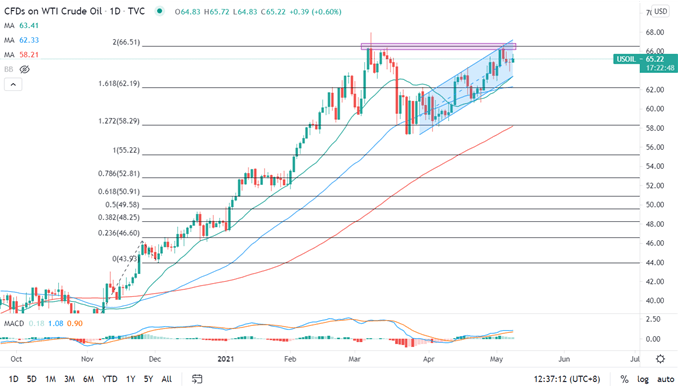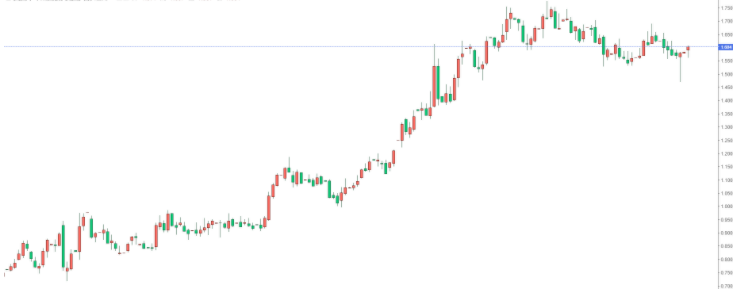
★
Summary
★
Oil prices rose in the Asia-Pacific region after Colonial Pipeline, a major oil pipeline in the United States, was shut down by a cyber attack. A much lower-than-expected US non-farm payrolls report sent the dollar down, and a weaker dollar could still pave the way for higher oil prices, given the historical negative correlation between the dollar and oil prices.
The Colonial pipeline, the largest product pipeline system in the United States, can transport more than 3 million barrels of gasoline, diesel and jet fuel between the Gulf Coast and the New York Harbor area, accounting for 45% of the supply on the East Coast of the United States. If the outage continues, there could be a rush to buy alternative fuels on the east coast and could push up oil prices. In addition, the refinery of Motiva, North America's largest refiner, in Port Arthur, Texas, will be shut down because of the outage of the Colonial pipeline, amid concerns that the event will lead to refining activity and a slowdown in gasoline imports, which in turn will have an impact on oil prices. The Federal Motor Transportation Safety Administration of the U.S. Department of Transportation declared a state of emergency in 17 states in the southeastern United States, including Texas and Tennessee, and Washington, D.C., on Monday (May 10).
It is important to note that the current US economic recovery is stimulating demand for car fuel, coupled with the return of driving in the spring, supply constraints are likely to lead to higher fuel prices. Us gasoline futures for May delivery rose 1.5 per cent to $2.16 a gallon on Monday. Experts say fuel prices could rise by 2-3%, but if the situation persists for longer, the impact will be much more serious than it is now. Commerce Secretary Raimundo said restoring pipeline operations is a top priority for the Biden administration, and Washington is helping Colonial restart its more than 8850 kilometers of pipeline from Texas to New Jersey as soon as possible to avoid more serious fuel disruption.
Back on Friday, a much lower-than-expected U. S. non-farm payrolls report sent the dollar down. However, oil prices barely responded as the market weighed sluggish job growth and its impact on the outlook for fuel demand. Nevertheless, given the historical negative correlation between the dollar and oil prices, a weaker dollar could pave the way for higher oil prices.
In addition, concerns about pandemics remain a top priority for investors as the recurrence of the epidemic has caused trouble for some of Asia's largest energy importers. India has reported more than 400,000 new Covid-19 cases a day for four consecutive days, and infection rates in Japan are also rising on Friday and Saturday. Recent data show a decline in crude oil imports and gasoline sales in both countries as a result of travel restrictions and blockades. India and Japan are the world's third and fourth largest oil importers respectively. Together, the two countries consumed about 17 per cent of global oil exports during 2019.
WTI crude closed up 0.09% on Monday, ending a three-day decline. However, compared with the strong rally in commodities after the non-farm report, investors seem to be on the sidelines about the future direction of oil prices. WTI crude oil is currently competing at the $65.0level and has twice stabilized the short-term support level of $64.50mentioned by the author, suggesting that the direction with less resistance in the future is still upward.

A group of Fed officials appeased the market's "transitional" reaction on Monday after the weak non-farm report was released. The Fed's Mary Daly said it was not so disappointed with the April jobs report and should not call the current situation a "worker shortage". The labor market is in a changing state, there are many constraints, and said that stock market valuations can be seen to be quite high; Dallas Fed Chairman Robert Kaplan said that in recognition of excessive risk-taking in financial markets, it would be healthier to start talking about scaling back bond purchases as soon as possible, while US President Joe Biden said that in the coming months, the United States will see the fastest economic growth in 40 years.
It is worth noting that the recent decline in both US dollar and US bond yields seems to be about to change. The 10-year US bond yield once fell to 1.469% after the non-farm sector, but has now recovered all the decline and recovered to above 1.6% level. At the same time, the dollar index has also entered the 90.0-90.2 regional support, suggesting that the short-term decline may come to an end.

It is clear that, excluding commodities, non-US currencies and US stock markets have overreacted to the non-farm report, as weakness will boost Biden's infrastructure plan, which in turn will accelerate the US economic recovery. especially at a time when a series of US economic data show strong momentum of recovery. Therefore, investors still need to be wary of the pressure on oil prices caused by the rebound in both short-term US dollars and US bond yields.
Looking ahead, look at Wednesday's US inflation data and Friday's retail sales growth rate for clues about price levels and the health of consumer spending. Wednesday's API crude oil inventory data will also be closely watched.
Risk Warning: The above content is for reference only, and does not represent JRFX’s position. JRFX does not assume any form of loss caused by any trading carried out in accordance with this article. Please consult your financial planner for your investment portfolios and manage your own risk.
JRFX is an online CFD broker providing more than 50 products for Forex, metals and commodities. Open a trading account within a minute. Deposit 100USD and download our MT4 trading platform now!

|

|

|

|

Views: 118013

Likes: 0